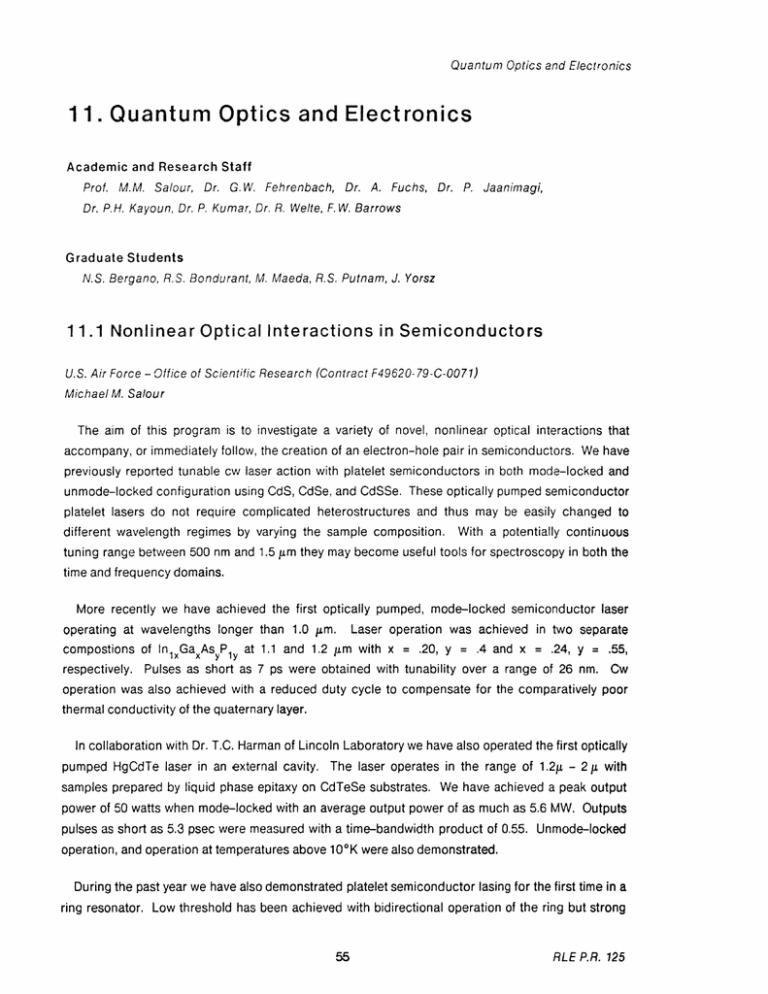11. Quantum Optics and Electronics
advertisement

Quantum Optics and Electronics 11. Quantum Optics and Electronics Academic and Research Staff Prof. M.M. Salour, Dr. G.W. Fehrenbach, Dr. A. Fuchs, Dr. P. Jaanimagi, Dr. P.H. Kayoun, Dr. P. Kumar, Dr. R. Welte, F.W.Barrows Graduate Students N.S. Bergano, R.S. Bondurant, M. Maeda, R.S. Putnam, J. Yorsz 11.1 Nonlinear Optical Interactions in Semiconductors U.S. Air Force - Office of Scientific Research (Contract F49620-79-C-0071) Michael M. Salour The aim of this program is to investigate a variety of novel, nonlinear optical interactions that accompany, or immediately follow, the creation of an electron-hole pair in semiconductors. We have previously reported tunable cw laser action with platelet semiconductors in both mode-locked and unmode-locked configuration using CdS, CdSe, and CdSSe. These optically pumped semiconductor platelet lasers do not require complicated heterostructures and thus may be easily changed to different wavelength regimes by varying the sample composition. With a potentially continuous tuning range between 500 nm and 1.5 /m they may become useful tools for spectroscopy in both the time and frequency domains. More recently we have achieved the first optically pumped, mode-locked semiconductor laser operating at wavelengths longer than 1.0 pFm. Laser operation was achieved in two separate compostions of In1xGaxAsyP 1 y at 1.1 and 1.2 jpm with x = .20, y = .4 and x = .24, y = .55, respectively. Pulses as short as 7 ps were obtained with tunability over a range of 26 nm. Cw operation was also achieved with a reduced duty cycle to compensate for the comparatively poor thermal conductivity of the quaternary layer. In collaboration with Dr. T.C. Harman of Lincoln Laboratory we have also operated the first optically pumped HgCdTe laser in an external cavity. The laser operates in the range of 1.2tp - 2 Ip with samples prepared by liquid phase epitaxy on CdTeSe substrates. We have achieved a peak output power of 50 watts when mode-locked with an average output power of as much as 5.6 MW. Outputs pulses as short as 5.3 psec were measured with a time-bandwidth product of 0.55. Unmode-locked operation, and operation at temperatures above 100 K were also demonstrated. During the past year we have also demonstrated platelet semiconductor lasing for the first time in a ring resonator. Low threshold has been achieved with bidirectional operation of the ring but strong RLE P.R. 125 Quantum Optics and Electronics coupling effects have thus far prevented unidirectional operation. 11.2 Picosecond Dye Laser Optics Joint Services Electronics Program (Contract DAAG29-80-C-0104) U.S. Air Force - Office of Scientific Research (Contract F49620-79-C-0071) Michael M. Salour Our picosecond dye laser system has been extended to high power operation by the addition of four dye amplifier stages. A frequency-doubled, Q-switched Nd:YAG laser pumps the dye amplifiers in synchronism with a pulse from the train of a synchronously-mode-locked dye oscillator. A pulse from the oscillator is then amplified to peak powers of several gigawatts (for pulse duration of several picoseconds at a repetition rate of 10 Hz). An electron-optic streak camera, interfaced to a multichannel analyzer and minicomputer, has been adapted for use at the 10 Hz repetition rate. For the system's initial demonstration we have performed time resolved laser induced fluorescence spectroscopy of the hydroxyl radical in flame. The results reported extend previous measurements of OH211(v' = 0) quenching rates in subatmospheric pressure flames to atmospheric pressures. The application of this technique to even higher pressure flames appears feasible. The collisional quenching lifetime following excitation of the R2 (4) 2 H(v' =0)<---2 +(v' ' =0) transition was measured to be 1.8 ns in the burned gas region of an atmospheric pressure, premixed methane-air flame. We have also reported the first experimental technique for compensating the pulse broadening in single-mode optical fibers, using the "slow" anomalous pulse propagation in the exciton-polariton resonance in a direct-gap semiconductor. Mode-locked dye laser pulses of 0.7-ps duration at 8180 A were propagated through a 100-m single-mode optical fiber and emerged with 2.8-ps duration. We have demonstrated the compensation of this pulse broadening in optical fibers by passage through a 6.3 - nm-thick GaAs crystal, taking advantage of the group velocity dispersion around the discrete n = 1 exciton-polariton resonance. 1 1.3 Nonlinear Spectroscopy of Atoms and Molecules U.S. Navy - Office of Naval Research (Contract N00014-79-C-0694) Michael M. Salour A series of novel experiments has been initiated to study the photon statistics of light produced by degenerate 4-wave mixing (DFWM). The goal of this work is the generation of light in two-photon coherent stages. RLE P.R. 125 Quantum Optics and Electronics Considerable advance has been made in achieving the laser stability required for the observation of non-classical statistics. Output from a frequency-stable ring dye laser is amplified in a 3-stage dye amplifier pumped by a frequency-doubled 0-switched Nd:YAG laser. Use of a novel pulse shaping network has resulted in the generation of nearly transform-limited pulses of 4 nsec duration. DFWM has been observed in Na vapor. So far, photon counting measurements made both on reflected and transmitted probe beams have yielded Poisson statistics. High loss and background fluorescence has restricted these measurements to the regime of classical statistics. Several alternative schemes are being pursued. RLE P.R. 125 RLE P.R. No. 125 58




